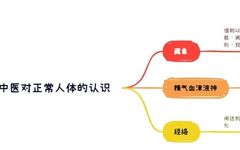Meridians
Meridians are an important component of the human body’s structure, which, along with the organs, body shapes, and orifices, forms a complete human body. Meridians refer to the general term for the main and collateral channels. The main channels (jingmai) are the primary parts of the meridian system, running deep within the body along specific pathways; the collateral channels (luomai) are smaller branches of the main channels, running more superficially and interconnecting throughout the body.
For those without the book, you can send “Zhong Ji” to this public account, and the reading panda will send you the electronic version of the book.
This article has 4154 words and an estimated reading time of about 10 minutes.
The section “Understanding the Normal Human Body in Traditional Chinese Medicine” mainly includes the following modules:
1. Zangxiang (Organ Manifestations)
2. Jing, Qi, Xue, Jinye, Shen (Essence, Qi, Blood, Body Fluids, Spirit)
3. Meridians
The basic structure of this section is shown in the diagram below; we will now begin discussing each module.
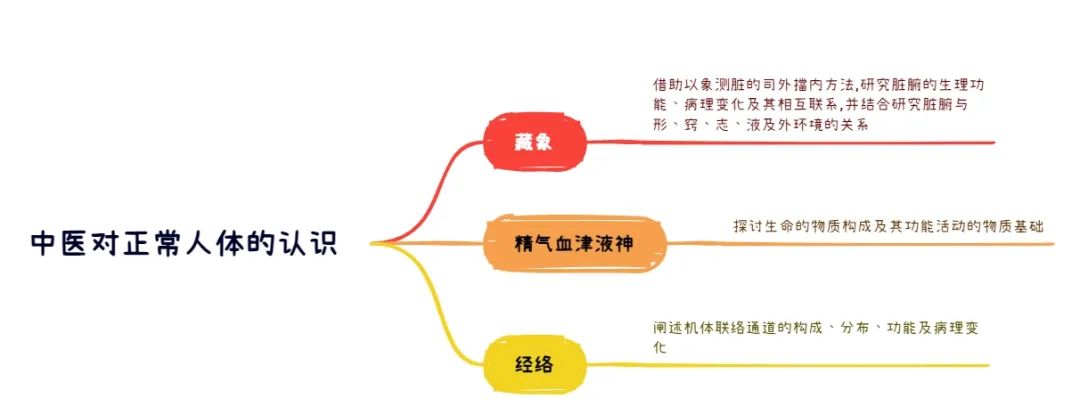
Click the image to enlarge
Meridians
1
Composition of the Meridian System
The meridian system mainly includes the twelve primary channels, the eight extraordinary channels, and the fifteen collateral channels, as well as the twelve branch channels that branch off from the twelve primary channels.
1. Twelve Primary Channels
The twelve primary channels are the main parts of the meridians, divided into four groups of three yin and three yang channels, namely:
Hand Three Yin Channels (Shou Taiyin Fei Jing (Hand Taiyin Lung Channel), Shou Jueyin Xinbao Jing (Hand Jueyin Pericardium Channel), Shou Shaoyin Xin Jing (Hand Shaoyin Heart Channel)),
Hand Three Yang Channels (Shou Yangming Dazhang Jing (Hand Yangming Large Intestine Channel), Shou Shaoyang Sanjiao Jing (Hand Shaoyang Sanjiao Channel), Shou Taiyang Xiaochang Jing (Hand Taiyang Small Intestine Channel)),
Foot Three Yin Channels (Zu Taiyin Pijiang Jing (Foot Taiyin Spleen Channel), Zu Yin Gan Jing (Foot Yin Liver Channel), Zu Shaoyin Shen Jing (Foot Shaoyin Kidney Channel)),
Foot Three Yang Channels (Zu Yangming Wei Jing (Foot Yangming Stomach Channel), Zu Shaoyang Dan Jing (Foot Shaoyang Gallbladder Channel), Zu Taiyang Pangguang Jing (Foot Taiyang Bladder Channel)), collectively known as the twelve primary channels.
The twelve primary channels are also referred to as “Zhengjing” (Regular Channels), in contrast to the “Qijing” (Extraordinary Channels).
2. Eight Extraordinary Channels
The eight extraordinary channels include Du Mai (Governing Vessel), Ren Mai (Conception Vessel), Chong Mai (Penetrating Vessel), Dai Mai (Belt Vessel), Yin Qiao Mai (Yin Heel Vessel), Yang Qiao Mai (Yang Heel Vessel), Yin Wei Mai (Yin Linking Vessel), Yang Wei Mai (Yang Linking Vessel), collectively known as the eight extraordinary channels.
3. Fifteen Collateral Channels
The fifteen collateral channels are a larger part of the collateral channels. There are also superficial collaterals and sun collaterals. The superficial collaterals are distributed in the superficial parts of the body, while the sun collaterals, also known as the sun vessels, are the smallest parts of the collateral channels.
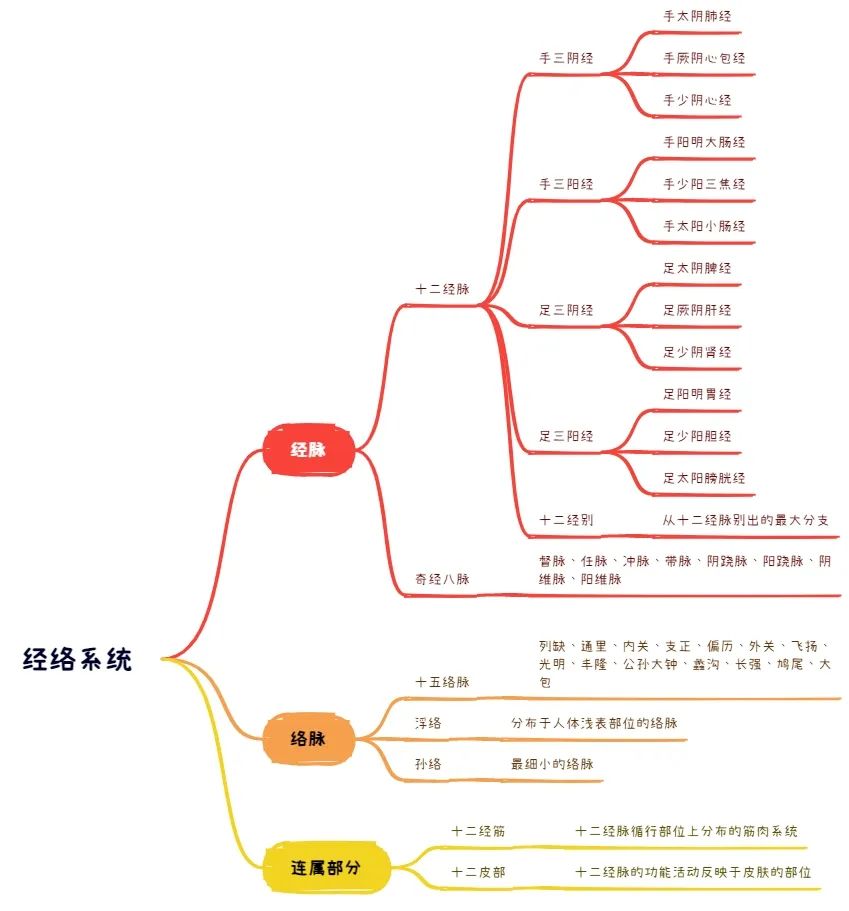
Click the image to enlarge
2
Distribution of the Meridians
(1) Distribution of the Twelve Primary Channels
The twelve primary channels are symmetrically distributed on both sides of the body, running along the inner or outer sides of the upper or lower limbs, with each channel corresponding to a specific organ or viscera, hence the different names of the twelve primary channels. The names of each channel consist of three parts: hand or foot, yin or yang, and organ or viscera, with the naming rules as follows.
“Hand and foot” indicates that the channel runs along the upper or lower limbs and its starting and ending points: hand channels run along the upper limbs, while foot channels run along the lower limbs. The starting and ending points are: the hand three yin channels end at the hand, and the hand three yang channels start at the hand; the foot three yang channels end at the foot, and the foot three yin channels start at the foot.
“Yin and yang” indicates that the channel runs along the inner or outer sides of the limbs: yin channels run along the inner side, while yang channels run along the outer side. The hand three yin channels run along the inner side of the upper limbs, while the hand three yang channels run along the outer side; the foot three yang channels run along the outer side of the lower limbs, while the foot three yin channels run along the inner side.
“Organ and viscera” indicates the organ or viscera to which the channel belongs: yin channels belong to organs, while yang channels belong to viscera.
The distribution rules of the twelve primary channels are as follows:
(1) Direction and Interconnection
The twelve primary channels are divided into four groups of three yin and three yang, namely hand three yin, hand three yang, foot three yin, and foot three yang. The direction of each group is consistent and follows a sequential order, forming the direction and interconnection rules of the twelve primary channels. As stated in the “Ling Shu: Reversal and Order of Fat and Thin”: “The three yin of the hand run from the organs to the hand; the three yang of the hand run from the hand to the head; the three yang of the foot run from the head to the foot; the three yin of the foot run from the foot to the abdomen.” This summarizes the directional rules of the twelve primary channels. The intersection of yin and yang channels occurs at the hands and feet; the intersection of yang channels occurs at the head and face; the intersection of yin channels occurs at the chest and abdomen.
The relationship between direction and interconnection is closely linked, and combining the two indicates: the hand three yin channels run from the chest to the hand, intersecting with the hand three yang channels; the hand three yang channels run from the hand to the head, intersecting with the foot three yang channels; the foot three yang channels run from the head to the foot, intersecting with the foot three yin channels; the foot three yin channels run from the foot to the abdomen and chest, intersecting with the hand three yin channels.
(2) Exterior-Interior Correspondence
The twelve primary channels communicate with each other through branch channels and collateral channels, forming six pairs, also known as “Liuhe” (Six Harmonies), which represent the “exterior-interior correspondence” relationship. The “Su Wen: Blood, Qi, Form, and Will” states: “The foot taiyang and shaoyin are exterior-interior; shaoyang and jueyin are exterior-interior; yangming and taiyin are exterior-interior, which is the foot yin and yang; the hand taiyang and shaoyin are exterior-interior; shaoyang and heart master are exterior-interior; yangming and taiyin are exterior-interior, which is the hand yin and yang.”
The two channels that correspond in exterior and interior intersect at the ends of the limbs, running along the inner and outer sides of the limbs, and correspond to the organs or viscera that are mutually exterior-interior.
The exterior-interior correspondence relationship of the twelve primary channels strengthens the connection between the two channels, while also enhancing the structural connection between the corresponding organs and viscera, thus allowing for physiological cooperation and pathological interaction.
(3) Flow Order
The twelve primary channels are distributed throughout the body, with the flow of qi, blood, yin, and yang being continuous and circulating, which is the flow of the twelve primary channels. This flow has a specific order, starting from the Shou Taiyin Fei Jing (Hand Taiyin Lung Channel), flowing successively to the Zu Jueyin Gan Jing (Foot Jueyin Liver Channel), and then back to the Shou Taiyin Fei Jing. This forms a cycle of “yin and yang interpenetrating, like a ring without end”.
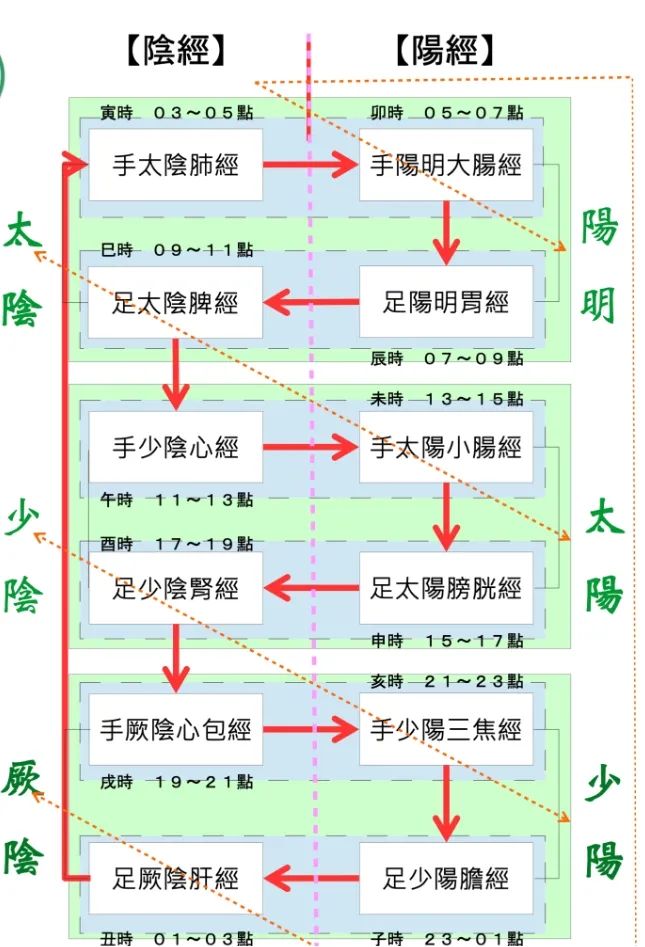
(4) Surface Distribution
The distribution of the twelve primary channels on the body surface also follows certain rules.
1. Head and Face: The hand three yang channels end at the head and face, while the foot three yang channels start at the head and face, thus they intersect at this area, which is why it is said that “the head is the meeting place of all yang channels”.
The characteristics of the distribution of the twelve primary channels in the head and face are: the hand and foot yangming channels are distributed in the forehead area; the hand taiyang channel is distributed in the cheek area; the hand and foot shaoyang channels are distributed in the ear and temple area; the foot taiyang channel is distributed in the top of the head and nape. Additionally, the foot jueyin channel ends at the top of the head from within the skull.
The distribution of the twelve primary channels in the head and face can be summarized as: yangming in the front, shaoyang on the side, and taiyang in the back.
2. Limbs: The general rule for the distribution of the twelve primary channels in the limbs is: yin channels are distributed on the inner side of the limbs, while yang channels are distributed on the outer side.
Upper Limbs: The inner side is where the Shou Taiyin Jing is at the front edge, the Shou Jueyin Jing is at the midline, and the Shou Shaoyin Jing is at the back edge. The outer side is where the Shou Yangming Jing is at the front edge, the Shou Shaoyang Jing is at the midline, and the Shou Taiyang Jing is at the back edge.
Lower Limbs: The inner side is below eight cun above the inner ankle, where the Zu Jueyin Jing is at the front edge, the Zu Taiyin Jing is at the midline, and the Zu Shaoyin Jing is at the back edge; above eight cun, the Zu Taiyin Jing is at the front edge, the Zu Jueyin Jing is at the midline, and the Zu Shaoyin Jing is at the back edge. The outer side is where the Zu Yangming Jing is at the front edge, the Zu Shaoyang Jing is at the midline, and the Zu Taiyang Jing is at the back edge.
3. Trunk: The general rule for the distribution of the twelve primary channels in the trunk is: the Zu San Yin and Zu Yangming channels are distributed in the chest and abdomen (front), while the Shou San Yang and Zu Taiyang channels are distributed in the shoulder blades, back, and waist (back), and the Shou San Yin, Zu Shaoyang, and Zu Jueyin channels are distributed in the armpit, ribs, and lateral abdomen (side).

(5) Internal Distribution
Internal refers to the thoracic and abdominal cavities, including the organs. The twelve primary channels all run into the thoracic and abdominal cavities. The distribution of the twelve primary channels within the body mainly refers to their connection with the organs, hence it is said that the twelve primary channels “internally belong to the viscera” (“Ling Shu: Sea Discussion”).
The connection between the twelve primary channels and the organs mainly involves the “belonging” and “collateral” relationships. “Belonging” means subordination. Each of the twelve primary channels belongs to a specific organ or viscera. “Collateral” means connection. Each of the twelve primary channels is connected to the corresponding exterior-interior channel of the organ or viscera. This forms the connection pattern of the twelve primary channels with the organs, where the hand and foot three yin channels belong to the organs and the hand and foot three yang channels belong to the viscera, as shown in Table 4-3.
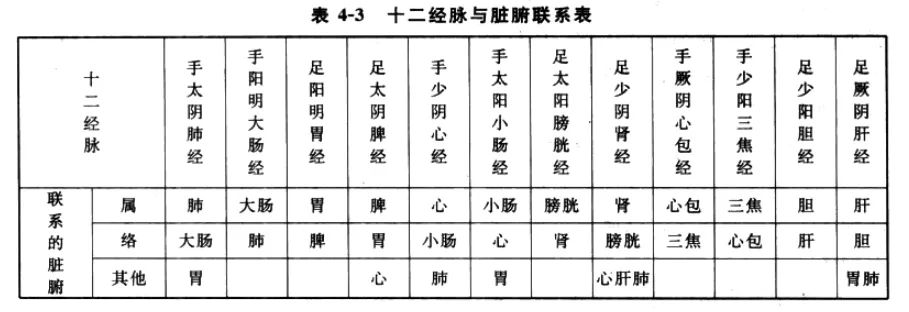
Some of the channels among the twelve primary channels also connect with other related organs along their pathways. For example, the Shou Taiyin Fei Jing connects to the stomach, the Zu Taiyin Pijiang Jing connects to the heart, the Shou Shaoyin Xin Jing connects to the lung, the Shou Taiyang Xiaochang Jing connects to the stomach, the Zu Shaoyin Shen Jing connects to the heart, liver, and lung, and the Zu Jueyin Gan Jing connects to the stomach and lung. The organs have fixed positions in the thoracic and abdominal cavities, thus the connection between the twelve primary channels and the organs represents the main areas of distribution of the twelve primary channels within the body.
(2) Distribution of the Eight Extraordinary Channels
The eight extraordinary channels refer to the Du Mai, Ren Mai, Chong Mai, Dai Mai, Yin Qiao Mai, Yang Qiao Mai, Yin Wei Mai, and Yang Wei Mai, which are important components of the meridian system. The term “extraordinary” indicates their distinct nature. The eight extraordinary channels are a different category of channels compared to the twelve primary channels (regular channels). Their distribution is not as regular as that of the twelve primary channels and does not have a direct belonging or collateral relationship with the organs, nor do they have an exterior-interior correspondence relationship, and they lack branch channels, sinews, and skin areas, hence they are called “extraordinary channels”.
The names of the eight extraordinary channels do not follow the common rules of hand and foot, yin and yang, and organs like the twelve primary channels, but rather reflect their individual characteristics. Du means to lead or govern; Ren means to bear or nurture; Chong means to penetrate or traverse; Dai means to bind or encircle; Qiao means to leap or be agile; Wei means to connect or link. The yin and yang Qiao channels indicate the channels running along the inner or outer sides of the lower limbs.
The distribution rules of the eight extraordinary channels are as follows.
The eight extraordinary channels are distributed in a crisscross manner between the twelve primary channels on the body surface. Although their distribution is not as regular as that of the twelve primary channels, they still have their own distribution rules on the body surface.
The Du, Ren, and Chong channels all originate from the womb, emerging from the perineum, and then diverge to distribute in the waist, back, chest, and abdomen, hence these three channels are referred to as “one source with three divergences” (“Classified Classic: Diagram Wings”).
Du Mairuns from the perineum backward and upward, distributing along the midline of the waist and back, then through the neck, head, forehead to the lips; Ren Mai runs from the perineum forward and upward, distributing along the midline of the abdomen and chest, through the throat, lips to the area below the eye sockets. The Du and Ren channels not only share the same starting point but also connect at the lips, forming a close relationship between the two channels.
Chong Mairuns from the perineum forward and upward, passing alongside the navel, and directly ascends, mainly distributing in the abdomen and chest.
Dai Maiencircles the waist and abdomen, wrapping around the body like a belt.
The Qiao and Wei channels are both divided into yin and yang and are symmetrically distributed. Yin Qiao Mai starts below the inner ankle, with one on each side, and mainly distributes along the inner side of the legs and in the abdomen and chest; Yang Qiao Mai starts below the outer ankle, with one on each side, and mainly distributes along the outer side of the legs and in the lateral abdomen, chest, and shoulder area. Yin Wei Mai starts on the inner side of the lower leg, with one on each side, and mainly distributes along the inner side of the thighs and in the abdomen and chest; Yang Wei Mai starts below the outer ankle, with one on each side, and mainly distributes along the outer side of the legs and in the back and sides of the head.
(3) Distribution of the Collateral Channels, Branch Channels, Sinews, and Skin Areas
(1) Collateral Channelsare small branches that diverge from the primary channels, differing from the larger branches of the primary channels. The larger branches of the primary channels are still considered part of the primary channels, while the collateral channels belong to the collateral category. There are fifteen collateral channels, hence they are called the fifteen collateral channels.
Regarding the fifteen collateral channels, there are slight differences between the “Ling Shu” and the “Nan Jing”. The fifteen collateral channels mentioned in the “Ling Shu” refer to the twelve primary channels and the two channels of Du and Ren, each having one collateral channel, plus the large collateral of the spleen, totaling fifteen collateral channels. The “Nan Jing: Twenty-six Difficulties” states: “There are twelve primary channels, fifteen collaterals, and what are the other three collaterals? There are yang collaterals, yin collaterals, and the large collateral of the spleen. The yang collateral is the collateral of the yang qiao; the yin collateral is the collateral of the yin qiao, hence there are fifteen collaterals.” Currently, the general reference is based on the content in the “Ling Shu”.
The names of the fifteen collateral channels are based on the acupoints from which they branch. Specifically as follows:
Shou Taiyin Jing Collateral Channel — Lieque;
Shou Shaoyin Jing Collateral Channel — Tongli;
Shou Yin Jing Collateral Channel — Neiguan;
Shou Taiyang Jing Collateral Channel — Zhizheng;
Shou Yangming Jing Collateral Channel — Pianli;
Shou Shaoyang Jing Collateral Channel — Waiguan;
Zu Taiyang Jing Collateral Channel — Feiyang;
Zu Shaoyang Jing Collateral Channel — Guangming;
Zu Yangming Jing Collateral Channel — Fenglong;
Zu Taiyin Jing Collateral Channel — Gongsun;
Zu Shaoyin Jing Collateral Channel — Dazhong;
Zu Yin Jing Collateral Channel — Ligou;
Du Mai Branch Channel — Changqiang;
Ren Mai Branch Channel — Jiuwai (Tail Wing);
Spleen’s Large Collateral — Dabao.
The distribution of the fifteen collateral channels also follows certain rules. Among the twelve primary channels, the collateral channels are mainly distributed in the limbs, branching off below the elbows and knees, with the collateral channels of the exterior-interior channels connecting with each other—the direction of the collateral channels of the yin channels corresponds to that of the yang channels, and vice versa. A few collateral channels also enter the thoracic and abdominal cavities, connecting with the internal organs. The collateral channel of the Ren Mai is distributed in the abdomen, while the collateral channel of the Du Mai is distributed in the back, and the large collateral of the spleen is distributed in the chest and ribs.
The starting and ending points and the flow of the fifteen collateral channels have certain characteristics, as stated in the “Hui Xi Mai Xue”: “The fifteen collaterals are the connections of the primary channels. Their ends diverge from the primary channels, and their branches are scattered and varied, unlike the primary channels which are like a ring without end. Due to their oblique paths to the left and right, they are called collaterals.”
(2) Branch Channels
The twelve branch channels are the primary channels that diverge from the twelve primary channels, running through the chest, abdomen, and head, serving as important branches.
The flow of the twelve branch channels diverges from the parts of the twelve primary channels that run through the limbs (mostly above the elbows and knees), entering the internal cavities and organs (referred to as “entering”), and then emerging superficially (referred to as “exiting”), and finally ascending to the head. The branch channels of the yin channels merge with those of the yang channels and respectively flow into the six yang channels (referred to as “merging”). Therefore, the flow characteristics of the twelve branch channels can be summarized as “diverging, merging, exiting, and entering”.
(3) Sinews
The sinews are the system that connects the twelve primary channels to the muscles, and their functional activities rely on the nourishment of qi and blood from the meridians, and are regulated by the twelve primary channels, thus they are also divided into twelve systems, referred to as “twelve sinews”.
(4) Skin Areas
The skin areas refer to the skin on the body surface divided according to the distribution of the meridians. The twelve primary channels and their corresponding collateral channels have specific distribution ranges on the body surface, and the skin of the entire body is also divided into twelve parts, referred to as the twelve skin areas. As stated in the “Su Wen: Discussion on Skin Areas”: “To know the skin areas, use the meridians as a guide”; “All twelve meridians are the skin areas.” Therefore, the skin areas represent the divisions of the twelve primary channels and their corresponding collateral channels on the skin surface, and are also the areas where the qi of the twelve primary channels is distributed.
Thank you for reading to the end.
Give a “like” + “look” and “share” it with more people.
If you want to follow me,
don’t get lost.
Long press the QR code below or click the card
to recognize and follow.


